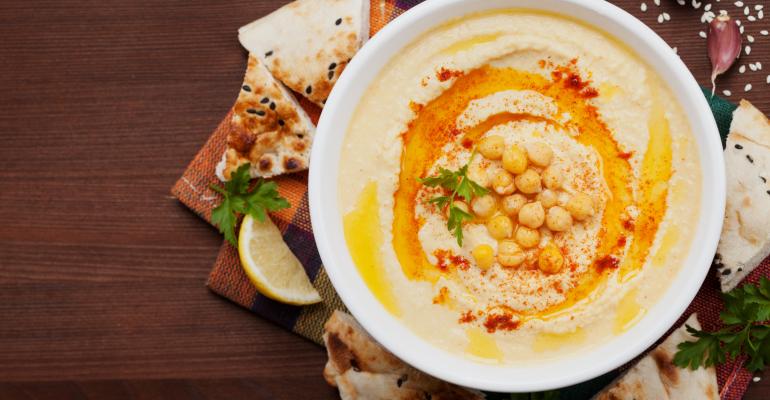Appetizers are the quintessential way to “set the table” for a meal. An appealing appetizer displays a certain “wow” or fun factor and is easy to share. It also reaches the table quickly, so simply and quickly prepared choices are the most appetizer-friendly.
For many operators, the best way to fulfill those requirements is to build a starter menu around labor-saving ingredients and cross-utilization. Here are some ways to harvest the low-hanging fruit.
Hummus, a hero: Hummus is universally popular and easily made with on-hand ingredients, using either house recipes or seasoning mixes blended with chickpeas, lentils and other legumes. Ready-made or quickly prepared purees can be garnished with a splash of good quality olive oil and Middle Eastern herbs and spices, and served with olives and toasted pita, premium crackers, lavosh or vegetables. Hummus is also a relatively stable workhorse that can add flavor and creamy texture as a base for proteins, in a composed salad and as a sandwich or wrap spread.
Quick queso: House-made or purchased tortilla chips paired with this patron-friendly cheese are a winning snack or appetizer for any casual operation. “Blending a prepared queso and salsa verde and adding sweet summer corn kernels — especially local corn — allows you to easily go big on flavor while applying a seasonal touch,” says Rob Corliss, president of All Things Epicurean (ATE), a Nixa, Mo.-based consultancy.
Premium breads with spreads: Patrons of many restaurants might balk at the idea of paying for bread, but if it’s extraordinary and comes with flavored olive oil or butters, tapenade and other spreads and dips, that’s a different story. And an in-house pastry chef is not a must. Extraordinary bread is easily sourced these days. The Greenhouse Tavern in Cleveland, for instance, charges $8 for “Our Daily Bread,” served with seasonal butters and jams.
“It brings a little joy to the table,” says Stefano Cordoba, president of Seattle-based Cordoba Food Design.
Load it up: Loaded fries are an easily produced mainstay at many casual restaurants and college campuses, and the sky’s the limit when it comes to creativity. Toppings that reflect the overall menu direction can double down, borrowing from the entrée or sides sections for efficiency with options like pizza-style, barbecue and Greek-themed fries.
On board: Arguably the easiest appetizer is a shareable board composed of ready-made cured meats, cheeses, bread and crackers, relishes and spreads, toasted walnuts and other elements that tie in with the restaurant’s overall positioning — especially if at least part of it is a house specialty. “A strategy of cross-utilizing existing menu components beloved by your guests in a new, creative fashion can extend the established equity of those flavors,” Corliss says.
Seafood: It’s in high demand, easily sourced in cooked/prepped form, and “consumers don’t know how to cook it properly,” Cordova says, so many look for seafood when dining out. Simple dishes built around shrimp, calamari, crabmeat and other seafood products can be made more memorable by being paired with updated variations on the same-old sauces and dips. Poke can work well as an appetizer as well. Corliss says precut, vacuum-packed cubes of raw ahi tuna simplify preparation The tuna cubes simply need to be tossed with a sesame/sriracha/soy sauce and served over seaweed salad.
Minis and shooters: A high-impact way to leverage other courses, single-bite themed sampler plates provide high visual appeal and introduce diners to other parts of the menu. Think vegetable purees, seasonal produce or bites of luxury proteins like Kobe beef, for example. Shot glasses containing three drinkable variations on a theme — typically soup — make for a showy first course. Bold colors and judicious use of garnishes such as fresh, flavor-spiked oils and pesto improve the likelihood of social media shares.
Skewer it: Middle Eastern food is hot, says menu expert Nancy Kruse, president of the Kruse Company, and kebabs are a simple way to showcase the cuisine, provide a portable options for diners and keep a lid on portion sizes, especially protein. Skewering isn’t limited to the Middle East; a Mediterranean theme could mix the classic Caprese combination of tomatoes and buffalo mozzarella with artichoke hearts and calamata olives, drizzled with a prepared basil-pesto vinaigrette.
Cordoba says millennials and Gen Z diners are looking for several qualities in an appetizer, including shareability, portability and photogenicity. Also, he says, younger customers tend to eat with one hand.
“When you are designing a menu, you have to have things that can be eaten with just a fork or simply picked up,” he advises.




